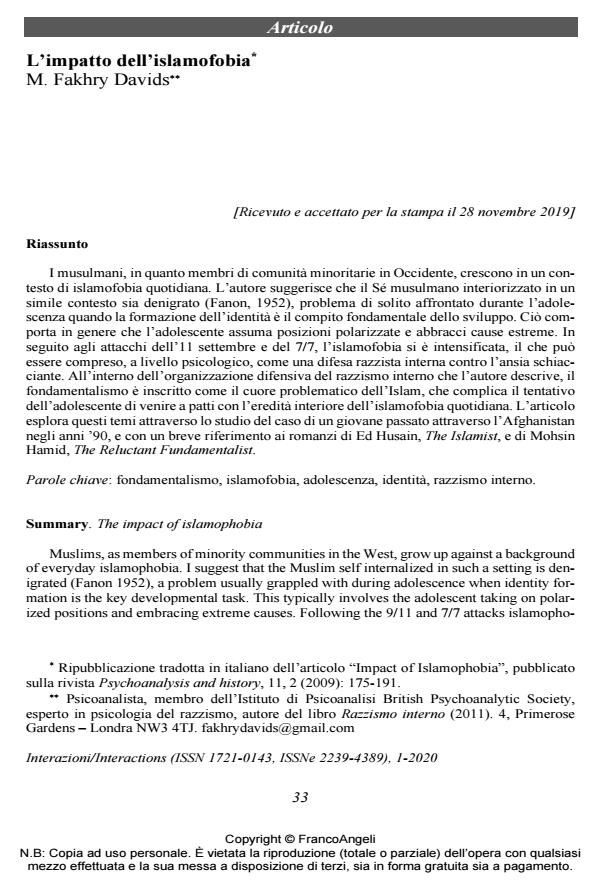L’impatto dell’islamofobia
Titolo Rivista INTERAZIONI
Autori/Curatori M. Fakhry Davids
Anno di pubblicazione 2020 Fascicolo 2020/1 Lingua Italiano
Numero pagine 19 P. 33-51 Dimensione file 207 KB
DOI 10.3280/INT2020-001003
Il DOI è il codice a barre della proprietà intellettuale: per saperne di più
clicca qui
Qui sotto puoi vedere in anteprima la prima pagina di questo articolo.
Se questo articolo ti interessa, lo puoi acquistare (e scaricare in formato pdf) seguendo le facili indicazioni per acquistare il download credit. Acquista Download Credits per scaricare questo Articolo in formato PDF

FrancoAngeli è membro della Publishers International Linking Association, Inc (PILA)associazione indipendente e non profit per facilitare (attraverso i servizi tecnologici implementati da CrossRef.org) l’accesso degli studiosi ai contenuti digitali nelle pubblicazioni professionali e scientifiche
I musulmani, in quanto membri di comunità minoritarie in Occidente, crescono in un con-testo di islamofobia quotidiana. L’autore suggerisce che il Sé musulmano interiorizzato in un simile contesto sia denigrato (Fanon, 1952), problema di solito affrontato durante l’adolescenza quando la formazione dell’identità è il compito fondamentale dello sviluppo. Ciò comporta in genere che l’adolescente assuma posizioni polarizzate e abbracci cause estreme. In seguito agli attacchi dell’11 settembre e del 7/7, l’islamofobia si è intensificata, il che può essere compreso, a livello psicologico, come una difesa razzista interna contro l’ansia schiacciante. All’interno dell’organizzazione difensiva del razzismo interno che l’autore descrive, il fondamentalismo è inscritto come il cuore problematico dell’Islam, che complica il tentativo dell’adolescente di venire a patti con l’eredità interiore dell’islamofobia quotidiana. L’articolo esplora questi temi attraverso lo studio del caso di un giovane passato attraverso l’Afghanistan negli anni ’90, e con un breve riferimento ai romanzi di Ed Husain, The Islamist, e di Mohsin Hamid, The Reluctant Fundamentalist.;
Keywords:Fondamentalismo, islamofobia, adolescenza, identità, razzismo interno.
- Ahmed K. (2002). The Exeter experience. In MCB, Quest for Sanity: Reflections on September 11 and the Aftermath. London: Muslim Council of Britain.
- Allen C. (2002). Islamophobia in the EU post-September 11. In MCB, Quest for Sanity: Reflections on September 11 and the Aftermath. London: Muslim Council of Britain.
- Allen C., Nielsen J.S. (2002). Summary Report on Islamophobia in the EU after 11 September 2001. Vienna: European Monitoring Centre on Racism and Xenophobia.
- Blank D.R. (1999). A veil of controversy: The construction of a “Tchador Affair” in the French press. Interventions: International Journal of Postcolonial Studies, 1, 4: 536-554. DOI: 10.1080/13698019900510811
- Bunglawala I. (2002). British Muslims and the media. In MCB, Quest for Sanity: Reflections on September 11 and the Aftermath. London: Muslim Council of Britain.
- Bunglawala I. (2004). Review of Islamophobia: Issues, Challenges and Action, ed. R. Richardson. Report of the Commission on British Muslims and Islamophobia, 20 October 2004. http://www.mcb.org.uk/library/Inayat-Islamophobia.pdf
- Dalal F. (2002). Race, Colour and the Processes of Racialization: New Perspectives from Psychoanalysis, Group Analysis and Sociology. Hove, New York, NY: Brunner-Routledge.
- Davids M.F. (1996). Frantz Fanon: The struggle for inner freedom. Free Associations, 6, 2: 205-234.
- Davids M.F. (2003). The internal racist. Bulletin of the British Psychoanalytical Society, 39, 4: 1-15.
- Erikson E.H. (1968). Identity: Youth and Crisis. London: Faber and Faber.
- Fanon F. (1952). Black Skin, White Masks. London: Pluto Press, 1986.
- Fanon F. (1967). The Wretched of the Earth. Harmondsworth: Penguin.
- Hamid M. (2007). The Reluctant Fundamentalist. London, New York, NY: Penguin.
- Husain E. (2007). The Islamist. London, New York, NY: Penguin.
- Laufer M., Laufer M.E. (1984). Adolescence and Developmental Breakdown: A Psychoanalytic View. New Haven, CT: Yale University Press.
- MCB (2002). Quest for Sanity: Reflections on September 11 and the Aftermath. London: Muslim Council of Britain.
- RunnymedeTrust (1997). Islamophobia: A Challenge for Us All. London: The Runnymede Trust.
- Said E. (1997). Covering Islam. New York: Vintage.
- Seabrook J. (2004). Religion as a fig leaf for racism: The BNP is now riding a broader wave of respectable Islamophobia. The Guardian, 23 July.
- Segal H. (2003). The mind of the fundamentalist/terrorist: Not learning from experience – Hiroshima, the Gulf War and 11 September. News and Events Annual Issue. Available from: http://www.psychoanalysis.org.uk/
- Sheridan L. (2002). Religious discrimination: The new racism. In MCB, Quest for Sanity: Reflections on September 11 and the Aftermath. London: Muslim Council of Britain.
- Steiner J. (1987). The interplay between pathological organisations and the paranoid-schizoid and depressive positions. International Journal of Psychoanalysis, 68: 69-80.
- Stuttaford A. (2004). Veil of tears: Absurdity in France [21 April]. Retrieved 21 October 2004. -- Available from: http://www.nationalreview.com/stuttaford/stuttaford200404210855.asp
- Summers F. (2006). Fundamentalism, psychoanalysis, and psychoanalytic theories. Psychoanalytic Review, 93: 329-352. DOI: 10.1521/prev.2006.93.2.329.
- Treacher A. (2005). On postcolonial subjectivity. Group Analysis, 38, 1: 43-57.
- Whitaker B. (2002). Islam and the British press. In MCB, Quest for Sanity: Reflections on September 11 and the Aftermath. London: Muslim Council of Britain.
M. Fakhry Davids, L’impatto dell’islamofobia in "INTERAZIONI" 1/2020, pp 33-51, DOI: 10.3280/INT2020-001003